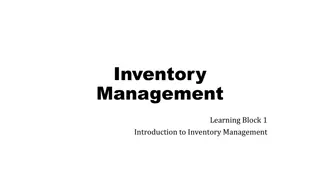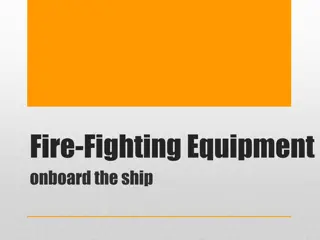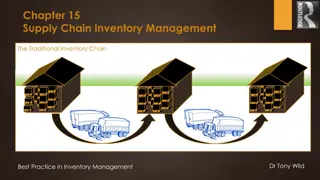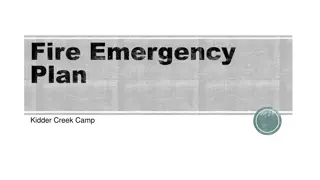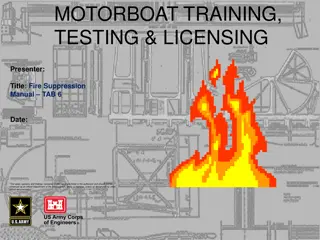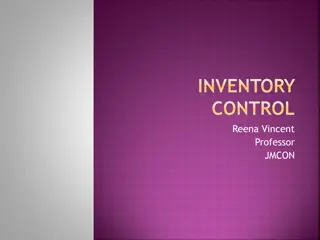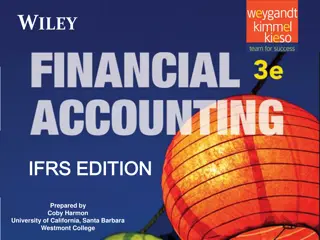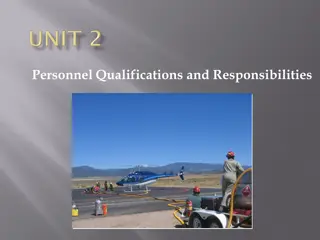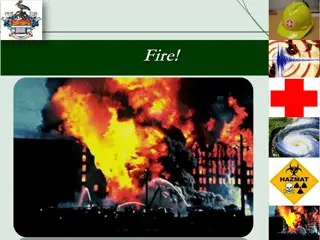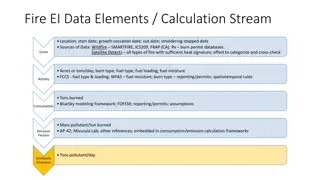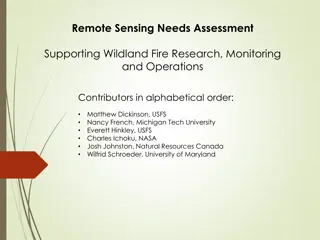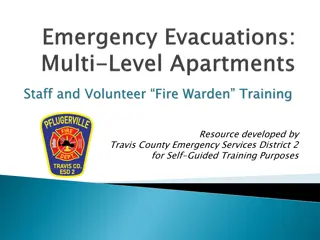
Uncertainty in Wildland Fire Emissions Inventory
Addressing the uncertainty and variability in biomass burning carbon emissions through integrating fuel properties, this project led by Nancy H.F. French aims to develop a comprehensive inventory for the western US. Collaborating with experts, the research focuses on fuel consumption models, remote sensing data analysis, and improving emissions calculation accuracy.
Download Presentation

Please find below an Image/Link to download the presentation.
The content on the website is provided AS IS for your information and personal use only. It may not be sold, licensed, or shared on other websites without obtaining consent from the author. If you encounter any issues during the download, it is possible that the publisher has removed the file from their server.
You are allowed to download the files provided on this website for personal or commercial use, subject to the condition that they are used lawfully. All files are the property of their respective owners.
The content on the website is provided AS IS for your information and personal use only. It may not be sold, licensed, or shared on other websites without obtaining consent from the author.
E N D
Presentation Transcript
Uncertainty and scaling of wildland fire emissions: Integrating variability in fuel properties for biomass burning carbon emissions inventory Uncertainty in biomass burning carbon emissions Principal Investigator: Nancy HF French, PhD Michigan Technological University Co-Investigators Michael Billmire, CMS-GIS/LIS Michigan Technological University Andrew Hudak, PhD Rocky Mountain Research Station, USDA Forest Service James Randerson, PhD University of California, Irvine Dar Roberts, PhD University of California, Santa Barbara Felix C Seidel, PhD (Presenter) Jet Propulsion Laboratory Collaborators Laura Bourgeau-Chavez, PhD, MTU Kevin Bowman, PhD, JPL Key Technical Staff Karen An, PhD, JPL Clare Saiki, UCSB Presented at the 2024 Science Team Meeting & Applications Workshop Washington, D.C. September 17-19, 2024
Figures reproduced from Carter et al. 2020 This Study Addresses the Role of Fuels in Fire Emissions Uncertainty Large uncertainty in the amount and composition of smoke The amount of vegetation fuel that is present and that burns the largest source of variability and uncertainty. (French et al. 2002, 10.1029/2001JD000480; Carter et al. 2020;, 10.5194/acp-20-2073-2020) Black Carbon (BC), Brown Carbon and other emissions are highly variable high uncertainty in radiative forcing. (Bond et al. 2013, 10.1002/jgrd.50171; Ramnarine et al. 2019, 10.5194/acp-19-6561-2019) 10.5194/acp-20-2073-2020 Top: Fig. 9a showing discrepancies in BC concentrations as observed in-situ from the DC3 airborne campaign (black line with error bars) and modeled using global fire emissions systems; Bottom: Fig. 4 showing disagreement between fuel (dry matter) densities for four fire emissions models, illustrating that fuels are a major source of uncertainty in fire emissions calculation.
Project Objectives & Approaches Objective 1: Develop a prototype wildland fire carbon emissions inventory with uncertainty for a 20-year period (2005 to 2024) for western US using WFEIS (Wildland Fire Emissions Inventory System) and GFED (Global Fire Emissions Database) by: Employing the NAWFD (North American Wildland Fuels Database; fuels.mtri.org), and Creating improved fuel consumption models that include uncertainty metrics. Integrate with CMS Flux pilot project for Western US (collaborator Bowman). Objective 2: Demonstrate collection, analysis, and use of remotely sensed data & products to derive fuels and fuel condition metrics. 1) Imaging spectroscopy for pre-fire fuel type mapping. 2) L-band synthetic aperture radar (SAR) fuel moisture. 3) Pre- and post-fire airborne lidar for fuel load, structure, and consumption. 4) Pre- and post-fire airborne SAR for fuel consumption. Illustration of fire emissions inventory accounting method used by WFEIS, GFED. Parts shown in orange are to be developed in this project. We will augment existing with new pre- & post-fire airborne data collected over fire-disturbed sites.
Relevance: Fires produce an average of ~3.0 Pg C year-1, with high variability. (0.91 to 4.75 Pg C yr 1 for 2002 to 2012 as CO2, CO, CH4 and other hydrocarbons) (Hantson et al. 2020, 10.5194/gmd-13-3299-2020) Boreal & temperate forests can be a Carbon Sink in most years, but a Carbon Source in years with large fires. (Kurz et al. 2008, 10.1073/pnas.0708133105, Byrne et al. 2024, Nature, 10.1038/s41586-024-07878-z) Contributions: 1. US Greenhouse gas (GHG) Center quantify impact of wildland fire emissions on carbon flux improve carbon accounting and reduced climate uncertainty improvements in GEOS-Carb CASA-GFED model 2. Convention on Long-Range Transboundary Air Pollution (LRTAP) quantify transport of air pollution US EPA for the Task Force on Hemispheric Transport of Air Pollution (HTAP) monitoring smoke from biomass burning is a current priority for LRTAP 3. FASMEE (USDA Forest Service Fire and Smoke Model Evaluation Experiment) 4. NASA FireSense Program, seeking to improve US wildland fire management 2021
Connections to CMS Needs & Stakeholders: CMS synthesis efforts and past projects: The WFEIS (Wildland Fire Emissions Inventory System) API was developed in part through CMS (French, PI) Current CMS project on Lidar for biomass (A Hudak, PI) Direct connection to the CMS Flux pilot project (K Bowman, PI) Burning Questions? Stakeholders: Emissions inventory products help address a need of the US EPA to Air Quality and Greenhouse gas reporting Improvements in monitoring smoke from biomass burning is a current priority (letter from Terry Keeting, US EPA) The study will benefit the Fuels and Fire Tools (FFT) management decision support system used by USDA Forest Service (letter from Susan Prichard, U Washington).






